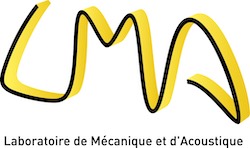Travail réalisé par L. Bodelot, J.-P. Voropaieff, K. Danas, N. Triantafyllidis
Laboratoire de Mécanique des Solides, Ecole Polytechnique, Université Paris-Saclay, 91128 Palaiseau, France
Magneto-Rheological Elastomers (MRE) are composite materials made of magnetizable metallic particles embedded in an elastomeric matrix. They belong to the class of smart materials since some of their properties, in particular their stiffness, can be modified by the application of an external stimulus, a magnetic field in their case. In the presence of a magnetic field, they can also exhibit large deformations, thus standing as promising candidates for a large number of engineering applications linked to tunable damping, non contact actuation or biological implants (valves, artificial muscles) [1]. The simplest form of MRE samples are isotropic due to a homogeneous dispersion of magnetizable spherical particles in their matrix, but curing these composites under magnetic fields can impart them with anisotropic properties through the creation of particle chains in the direction of the curing field.
The purpose of the present work is to develop a coupled experimental/numerical methodology for characterizing and modeling the coupled magneto-mechanical behavior of isotropic and anisotropic soft MREs that can sustain large deformations.
The first part of this work focuses on the fabrication of isotropic and anisotropic soft MREs. In particular, the question of interfacial adhesion is addressed through the determination of the critical strain threshold up to which the interfacial adhesion between the magnetizable particles and their host elastomeric matrix is ensured. In the second part of the study, an experimental setup is developed in order to characterize the behavior of isotropic and anisotropic MREs under coupled magneto-mechanical mechanical loadings. In the third part of this work, a continuum phenomenological modeling [2,3] of isotropic and anisotropic MREs is presented and the parameters of the model are obtained from the experimental data previously acquired.
References
[1] J. D. Carlson and M. R. Jolly. MR Fluid, Foam And Elastomer Devices. Mechatronics, 10, 2000.[2] S. V. Kankanala and N. Triantafyllidis. On Finitely Strained Magnetorheological Elastomers. Journal Of The Mechanics And Physics Of Solids, 52, 2004.
[3] K. Danas, S. V. Kankanala, and N. Triantafyllidis. Experiments And Modeling Of Iron-Particle-Filled Magnetorheological Elastomers. Journal Of The Mechanics And Physics Of Solids, 60, 2012.


